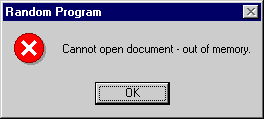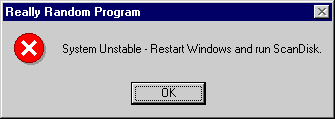Keep the Recommended Solutions Practical
While you should try to provide the user with a solution, don't bother unless you really know what the problem is. Whatever you do, don't give silly or impractical solutions. Here are some of my favorites:

Yeah, right.

Sounds good. Wait a minute—what if I am the network administrator?

OK, except I have 100 MB of free memory.

How much do you want to bet that the problem isn't with the hard disk but with the program reporting the error?
The first two error messages give solutions that aren't especially practical. In fact, they are not solutions at all. Basically, they say, "I don't know what is wrong and you don't know, so go ask somebody else." The third error message is a catchall that is unlikely to be right given the amount of free memory. An object couldn't be created and the problem was blamed on insufficient memory, but most likely the real problem is something else, such as an invalid input parameter, a missing file, a bad registry setting, or an unregistered COM object.
The last error message is by far the worst. What is wrong with this message? While a system disaster is possible, it is unlikely to be correctly diagnosed by a typical program. It's far more likely that the program itself has a serious bug and at this point doesn't know up from down. Instead of admitting to the bug, the program is suggesting that the user take draconian measures to solve a critical system problem that is most likely misdiagnosed. You should avoid blaming the system for problems and especially avoid recommending solutions like performing ScanDisk, reformatting the hard disk, reinstalling software, upgrading hardware, or contacting the computer manufacturer unless you really know what you are doing. Blaming program bugs on the system and suggesting that the user perform all sorts of drastic measures isn't going to score any points. Instead, it is likely to freak out the user. Many users are naïve enough to believe that error messages like this actually mean something.
Never propose a solution that isn't likely to be right. If you really don't know what is wrong, just say so. This is far better than having the user rebuild his system for nothing.
TIP
Keep the recommended solutions practical. Never propose a solution that isn't likely to be right.
EAN: 2147483647
Pages: 334